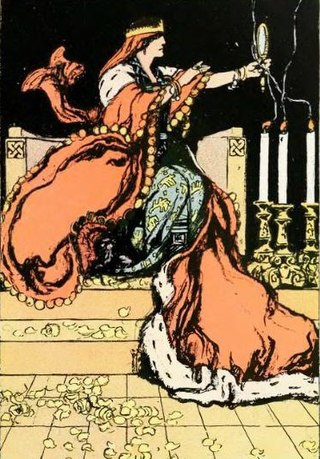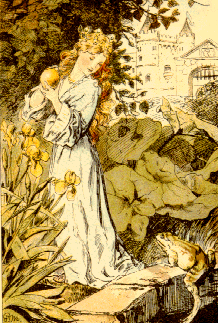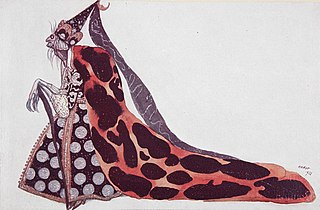
A fairy tale is a short story that belongs to the folklore genre. Such stories typically feature magic, enchantments, and mythical or fanciful beings. In most cultures, there is no clear line separating myth from folk or fairy tale; all these together form the literature of preliterate societies. Fairy tales may be distinguished from other folk narratives such as legends and explicit moral tales, including beast fables. Prevalent elements include dragons, dwarfs, elves, fairies, giants, gnomes, goblins, griffins, merfolk, monsters, talking animals, trolls, unicorns, witches, wizards, magic, and enchantments.

"Cinderella", or "The Little Glass Slipper", is a folk tale with thousands of variants that are told throughout the world. The protagonist is a young girl living in forsaken circumstances that are suddenly changed to remarkable fortune, with her ascension to the throne via marriage. The story of Rhodopis, recounted by the Greek geographer Strabo sometime between 7 BC and 23 AD, about a Greek slave girl who marries the king of Egypt, is usually considered to be the earliest known variant of the Cinderella story.

"Snow White" is a German fairy tale, first written down in the early 19th century. The Brothers Grimm published it in 1812 in the first edition of their collection Grimms' Fairy Tales, numbered as Tale 53. The original German title was Sneewittchen; the modern spelling is Schneewittchen. The Grimms completed their final revision of the story in 1854, which can be found in the 1857 version of Grimms' Fairy Tales.

"Sleeping Beauty", also titled in English as The Sleeping Beauty in the Woods, is a fairy tale about a princess cursed by an evil fairy to sleep for a hundred years before being awakened by a handsome prince. A good fairy, knowing the princess would be frightened if alone when she wakes, uses her wand to put every living person and animal in the palace and forest asleep, to awaken when the princess does.

Little Red Riding Hood is a European fairy tale about a young girl and a sly wolf. Its origins can be traced back to several pre-17th-century European folk tales. The two best known versions were written by Charles Perrault and the Brothers Grimm.

Maleficent is a fictional character who first appears in Walt Disney Productions' animated film, Sleeping Beauty (1959). Maleficent is a malevolent fairy and the self-proclaimed "Mistress of All Evil", she is an incarnation of pure evil and is responsible for all the misfortune in King Stefan's kingdom. Taking offense at not being invited to the christening of Princess Aurora by Stefan and his wife, Queen Leah, Maleficent curses the princess to "prick her finger on the spindle of a spinning wheel and die" before the sun sets on Aurora's sixteenth birthday. Maleficent is based on the Wicked fairy godmother character in Charles Perrault's fairy tale Sleeping Beauty.

"Rapunzel" is a German fairy tale most notably recorded by the Brothers Grimm and published in 1812 as part of Children's and Household Tales. The Brothers Grimm's story was developed from the French literary fairy tale of Persinette by Charlotte-Rose de Caumont de La Force (1698), which itself is an alternative version of the Italian fairy tale Petrosinella by Giambattista Basile.

The Evil Queen, also called the Wicked Queen or just the Queen, is a fictional character and the main antagonist of "Snow White", a German fairy tale recorded by the Brothers Grimm; similar stories exist worldwide. Other versions of the Queen appear in subsequent adaptations and continuations of the fairy tale, including novels and films. One particularly notable version is Disney's depiction, sometimes known as Queen Grimhilde. The character has also become an archetype that inspired unrelated works.

In fairy tales, a fairy godmother is a fairy with magical powers who acts as a mentor or parent to someone, in the role that an actual godparent was expected to play in many societies. In Perrault's Cinderella, he concludes the tale with the moral that no personal advantages will suffice without proper connections.

Prince Charming is a fairy tale stock character who comes to the rescue of a damsel in distress and must engage in a quest to liberate her from an evil spell. This classification suits most heroes of a number of traditional folk tales, including "Snow White", "Sleeping Beauty", and "Cinderella", even if in the original story they were given another name, or no name at all.

"The Frog Prince; or, Iron Henry" is a German fairy tale collected by the Brothers Grimm and published in 1812 in Grimm's Fairy Tales. Traditionally, it is the first story in their folktale collection. The tale is classified as Aarne-Thompson type 440.

Sleeping Beauty is a 1959 American animated musical fantasy film produced by Walt Disney Productions and released by Buena Vista Distribution. Based on Charles Perrault's 1697 fairy tale, the production was supervised by Clyde Geronimi, and was directed by Wolfgang Reitherman, Eric Larson, and Les Clark. Featuring the voices of Mary Costa, Bill Shirley, Eleanor Audley, Verna Felton, Barbara Luddy, Barbara Jo Allen, Taylor Holmes, and Bill Thompson, the film follows Princess Aurora, who was cursed by the evil fairy Maleficent to die from a prick from the spindle of a spinning wheel. She is saved by three good fairies, who alter the curse so that the princess falls into a deep sleep and is awakened by true love's kiss.

The Wicked fairy is the antagonist of Sleeping Beauty. In some adaptations, she is known as Carabosse. The most notable adaptation of the character is Maleficent, a Disney villain who appeared in various Disney media, beginning with the 1959 Walt Disney film Sleeping Beauty.

Snow White is a fictional character and a main character from Walt Disney Productions' first animated feature film Snow White and the Seven Dwarfs (1937). She was originally voiced by Adriana Caselotti. The character of Snow White was derived from a fairy tale known from many countries in Europe with the best-known version being the 1812 tale collected by the Brothers Grimm.

Aurora, also known as Sleeping Beauty or Briar Rose, is a fictional character who appears in Walt Disney Productions' animated film Sleeping Beauty (1959). Originally voiced by singer Mary Costa, Aurora is the only child of King Stefan and Queen Leah. An evil fairy named Maleficent seeks revenge for not being invited to Aurora's christening and curses the newborn princess, foretelling that she will prick her finger on a spinning wheel's spindle and die before sunset on her sixteenth birthday. Merryweather, one of the three good fairies, weakened the curse so Aurora would only sleep. Determined to prevent this, three good fairies raise Aurora as a peasant in order to protect her, patiently awaiting her sixteenth birthday—the day the spell can only be broken by a kiss from her true love, Prince Phillip.

Sleeping Beauty is a 1987 American/Israeli fantasy film, part of the 1980 film series Cannon Movie Tales. It is directed by David Irving and stars Tahnee Welch, Morgan Fairchild, Nicholas Clay and Sylvia Miles. It is a contemporary version of the classic tale of Sleeping Beauty of the Brothers Grimm and Charles Perrault. Like the other Cannon Movie Tales, the film was filmed entirely in Israel.

Flora, Fauna, and Merryweather are the three good fairies in Walt Disney's 1959 film Sleeping Beauty. They are characterized as Princess Aurora's fairy godmothers and guardians, who appear at baby Aurora's christening to present their gifts to her. The three were voiced by Verna Felton, Barbara Jo Allen, and Barbara Luddy, respectively.

Sleeping Beauty is a Disney media franchise that began in 1959 with the theatrical release of the animated film Sleeping Beauty, based on the homonymous fairy tale.


















